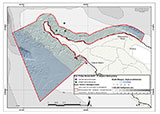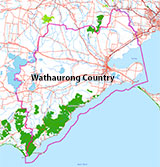Point Lonsdale Jetty
![]() Pier Dive |
Pier Dive | ![]() Shore access
Shore access
![]()
![]()
![]()
![]()
![]()
Depth: 3 m (9.84 ft) to 12 m (39 ft)
Point Lonsdale Jetty (also known as Point Lonsdale Pier, Lonsdale Jetty, and Lonsdale Point Pier) makes for an interesting dive under the jetty itself even though the water is shallow. This is ocean territory with a rocky bottom supporting plenty of marine life.
Entry and exit are best from the lower landing at the end of the pier, but entering and exiting from the shore is also popular.
Best dived during slack water with no swell when you can head North and East to patches of reef. But if you get it wrong you could be easily swept away. So short dives only, and best for experienced divers.
Another option here is to head South from the pier to the Point Lonsdale Kelp Forest.
The shipwrecks of the Black Boy, Gange, George Roper, Glaneuse and Holyhead lie nearby, but should only be explored by more advanced divers when the conditions are ideal.
Location: Point Lonsdale, Victoria 3225
MELWAY Ref: Page 499 J6
Beach Marker: 1B
Car parking is available and a toilet block can be found up by the lighthouse.
See WillyWeather (Point Lonsdale) as a guide for the tide times and the height of the tide. This dive site is also popular with snorkellers
The Rip & Tides Warning: Always keep an eye on sea conditions throughout any shore or boat dive within "The Rip" (aka "The Heads"). This is a dangerous stretch of water, where Bass Straight meets Port Phillip, which has claimed many ships and lives. Please read the warnings on the web page diving-the-rip before diving or snorkelling this site.
Port Phillip Heads Marine National Park
This site lies in the Port Phillip Heads Marine National Park. The park is made up of six separate marine areas around the southern end of Port Phillip: Swan Bay, Mud Islands, Point Lonsdale, Point Nepean, Popes Eye, and Portsea Hole.
Thirty-one of the 120 shipwrecks known to have occurred within a 10 nautical mile radius of Port Phillip Heads are thought to be within the Port Phillip Heads Marine National Park in Point Lonsdale and Point Nepean.
Aboriginal tradition indicates that the Bellarine Peninsula side of the Port Phillip Heads Marine National Park is part of Country of the Wathaurung people, and the Mornington Peninsula side, including Mud Islands, is part of Country of the Boon Wurrung people.
See also, Parks Victoria: Port Phillip Heads Marine National Park,
Park Note: Port Phillip Heads Marine National Park,
Port Phillip Heads Marine National Park - Map,
Divers Guide - Port Phillip Heads Marine National Park,
Port Phillip Heads Marine National Park Identification Booklet, and
Taxonomic Toolkit for the Marine Life of Port Phillip Bay.
You are not permitted to carry a spear gun while snorkelling or scuba diving in Port Phillip Heads Marine National Park.
Traditional Owners — This dive site is in the traditional Country of the Wathaurong (Wadda-Warrung) people of the Kulin Nation. This truly ancient Country includes the coastline of Port Phillip, from the Werribee River in the north-east, the Bellarine Peninsula, and down to Cape Otway in the south-west. We wish to acknowledge the Wathaurong as Traditional Owners. We pay respect to their Ancestors and their Elders, past, present and emerging. We acknowledge Bunjil the Creator Spirit of this beautiful land, who travels as an eagle, and Waarn, who protects the waterways and travels as a crow, and thank them for continuing to watch over this Country today and beyond.
Point Lonsdale Jetty Location Map
Latitude: 38° 17.498′ S (38.291637° S / 38° 17′ 29.89″ S)
Longitude: 144° 36.970′ E (144.616169° E / 144° 36′ 58.21″ E)
Datum: WGS84 |
Google Map
| Get directions
Added: 2012-07-22 09:00:00 GMT, Last updated: 2022-04-06 19:35:21 GMT
Source: Google Earth
Nearest Neighbour: Point Lonsdale Light, 38 m, bearing 241°, WSW
Port Phillip Heads Marine National Park.
Point Lonsdale, Bellarine Peninsula.
Depth: 3 to 5 m.
[ Top ]
DISCLAIMER: No claim is made by The Scuba Doctor as to the accuracy of the dive site coordinates listed here. Should anyone decide to use these GPS marks to locate and dive on a site, they do so entirely at their own risk. Always verify against other sources.
The marks come from numerous sources including commercial operators, independent dive clubs, reference works, and active divers. Some are known to be accurate, while others may not be. Some GPS marks may even have come from maps using the AGD66 datum, and thus may need be converted to the WGS84 datum. To distinguish between the possible accuracy of the dive site marks, we've tried to give each mark a source of GPS, Google Earth, or unknown.










